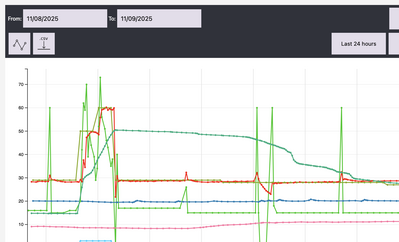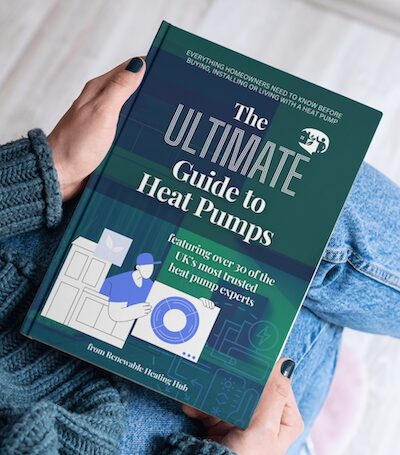Is Your House Warmer Upstairs Than Downstairs?
We are running our heat pump with weather compensation and a room thermostat set at 20C in the hall. In the last 24 hours, the temperature has mostly been very close to 20C. It dropped to 19.7C after the overnight hot water cycle and had just a few blips as high as 20.5C.
We have a wide staircase and quite a large landing. We leave all the bedroom doors open all the time, including at night. All the bedrooms have wide open TRVs. The bedroom radiators do not have FRVs and the lockshield valves may be fully open.
We are finding that all the upstairs rooms are running at about 21.5C - i.e. 1.5C warmer than the downstairs thermostat. We all know that hot air rises, so maybe this is just a natural result of convection?
I am wondering whether the upstairs radiators may have more water flow than they need. Therefore, I am considering installing FRVs in the bedrooms as a way to gently reduce the upstairs temperature and hopefully energy consumption.
I am interested to find out whether other people's systems have a similar temperature difference between upstairs and downstairs.
Grant Aerona 290 15.5kW, Grant Smart Controller, 2 x 200l cylinders, hot water plate heat exchanger, Single zone open loop system with TRVs for bedrooms & one sunny living room, Weather compensation with set back by room thermostat based load compensation
Posted by: @grahamfI am interested to find out whether other people's systems have a similar temperature difference between upstairs and downstairs
Until I turned down the lsvs upstairs, yes. No real need to buy frvs, lsvs, or trvs fitted with decorator caps to replace the heads, will do the same, albeit with slightly more fiddling, but it's a once only job. Having adjusted the bedrooms are slightly cooler than downstairs, which we prefer.
Posted by: @grahamfWe are running our heat pump with weather compensation and a room thermostat set at 20C in the hall
Before fiddling with the upstairs rads I would turn the downstairs thermostat up to 30 and adjust the weather compensation down to get the house temp right. This should maximise both efficiency and comfort.
4kW peak of solar PV since 2011; EV and a 1930s house which has been partially renovated to improve its efficiency. 7kW Vaillant heat pump.
Our arrangement of open doors etc. is very similar to yours but we have a requirement for a slightly higher temperature (22.5 deg. C) and we heat 24/7. I have employed the LSV’s to set the output from some radiators just to even out the room temperatures. On bedroom has a programmable TRV so that we may sleep in a cooler room. All the LSV’s downstairs are fully open and the Homely Mode (temperature probe) is in the living room. The maximum variation between rooms over perhaps a week or more might be 0.4 - 0.5 degrees C. so we find our comfort level to be very stable. We have one exception as we keep the bathroom LSV fully open and enjoy a slightly higher temperature and this we appreciate no end! Regards, Toodles.
Toodles, heats his home with cold draughts and cooks food with magnets.
We have smart TRVs in the bedrooms set at 20 or 21, but can set back further if required. We are operating under the principle that if used relatively sparingly (16 radiators in total with only 4 having TRVs) it should generally be ok, and this seems to work fine for us.
Fwiw I ried smart trvs with my gas heating. I found it too much faff to use the smart features so reverted to dumb trvs and subsequently, when I got my ashp, to no trvs. The most comfortable for me is the last of these, adjusted on the lsvs to be a bit cooler than the rest of the house and then left. Obviously this will differ from person to person and house to house but, before spending money, try the simplest possible solution.
4kW peak of solar PV since 2011; EV and a 1930s house which has been partially renovated to improve its efficiency. 7kW Vaillant heat pump.
@benson We have 10 radiators fitted with TRV’s only two are ‘active’ and I am contemplating replacing the other eight with decorator’s caps for neatness. (I blame the MCS for asking installers to fit TRV’s even though they are [in my opinion anyway] more of a source of problems if used extensively than they are of any practical use) Toodles.
Toodles, heats his home with cold draughts and cooks food with magnets.
Posted by: @grahamfWe all know that hot air rises, so maybe this is just a natural result of convection
Hi @grahamf, yes, exactly this. Unless you live in a house with all internal doors closed, high levels on insulation between downstairs and upstairs, and zero infiltration [air movement] between rooms, you'll get a thermal gradient between low and high elevation. CIBSE and ASHRAE guides have methods of calculating the rate of heat movement due to the natural buoyancy and the lower density of heated air, but to my knowledge, the phenomena is not considered in any heat loss and emitter sizing software. Nor have I seen any consideration of this or suitable correction factors that might be used in CIBSE's domestic heating design guide. CIBSE and Building Regulations assume the two levels are controlled as two zones, so heat can be demanded individually, but despite that being a BR requirement it's not efficient control with low & slow renewable heating where 'open loop' stable system flow rate is best.
It has become a much more prevalent phenomena in recent years due to better thermal insulation performance levels in houses & lower levels of air change in new build or well retrofitted housing stock. If I were to size emitters then for a typical 2 storey domestic dwelling with living space on the ground floor and bedrooms above, I would oversize downstairs by 10% and undersize upstairs by 10%, save for any WCs and bathrooms. Purely empirical 'wetted finger' numbers here, but there's a PHD research paper for some academic heat geek building services engineer on the subject. (They might already be on it...)
@allyfish thanks for your observations. At the moment, I suspect that my upstairs radiators are receiving too much water flow even without the +/-10% adjustments you suggest. I have decided to install FRVs upstairs, so that I have a more scientific flow control mechanism. However, I am not expecting them to make much difference.
Grant Aerona 290 15.5kW, Grant Smart Controller, 2 x 200l cylinders, hot water plate heat exchanger, Single zone open loop system with TRVs for bedrooms & one sunny living room, Weather compensation with set back by room thermostat based load compensation
Posted by: @grahamf@allyfish thanks for your observations. At the moment, I suspect that my upstairs radiators are receiving too much water flow even without the +/-10% adjustments you suggest. I have decided to install FRVs upstairs, so that I have a more scientific flow control mechanism. However, I am not expecting them to make much difference.
Why arent you expecting them to make much difference. If the water flow is shut off completely they wont heat at all, and in principle the flow could be adjusted to be anywhere between that (ie zero) and your current flow rate.
4kW peak of solar PV since 2011; EV and a 1930s house which has been partially renovated to improve its efficiency. 7kW Vaillant heat pump.
Posted by: @jamespaBefore fiddling with the upstairs rads I would turn the downstairs thermostat up to 30 and adjust the weather compensation down to get the house temp right. This should maximise both efficiency and comfort.
I followed your advice and the room temperature drifted up slightly to around 20.5C, even hitting 20.7C at one point. I am not sure that this was due to the thermostat temperature increase to 30C, as the very gentle upward trend had been continuing for several days - since we had our roof put back on!
Anyway, I adjusted the weather compensation Shift down from +2 to +1, the smallest adjustment possible. The temperature is now tracking 20C closely, without any intervention from the thermostat. The heat pump turns off, when the outlet water temperature gets too hot. The attached graph shows that it has been cold enough outside for the heat pump to cycle only a couple of times during the last 24 hours.
I am not expecting FRVs on the upstairs radiators to have much effect, because we leave all the doors open. I think convention will trump the FRVs. One option would be to close all the doors and then balance the temperatures, before opening the doors again. Our installer set the downstairs FRVs to match the radiator capacities, which seems like a good place to start.
Grant Aerona 290 15.5kW, Grant Smart Controller, 2 x 200l cylinders, hot water plate heat exchanger, Single zone open loop system with TRVs for bedrooms & one sunny living room, Weather compensation with set back by room thermostat based load compensation
Posted by: @grahamfI followed your advice and the room temperature drifted up slightly to around 20.5C, even hitting 20.7C at one point. I am not sure that this was due to the thermostat temperature increase to 30C, as the very gentle upward trend had been continuing for several days - since we had our roof put back on!
Anyway, I adjusted the weather compensation Shift down from +2 to +1, the smallest adjustment possible. The temperature is now tracking 20C closely, without any intervention from the thermostat. The heat pump turns off, when the outlet water temperature gets too hot. The attached graph shows that it has been cold enough outside for the heat pump to cycle only a couple of times during the last 24 hours.
Good, what Id expect, you may need to tweak the WC as the temperature cools down, but hopefully thats it
Posted by: @grahamfI am not expecting FRVs on the upstairs radiators to have much effect, because we leave all the doors open. I think convention will trump the FRVs. One option would be to close all the doors and then balance the temperatures, before opening the doors again.
As you obviously realise there is nothing the heating system can do to counter heat rising into open bedrooms if you want to maintain them at a lower temperature. You could balance the rooms with the doors closed, but if you always leave them open, whats the point, you are creating artificial conditions for the balancing which dont represent how you are going to operate. If the convection up the stairwell is too much your only options are
1. To have separate cooling upstairs (or open windows)
2. To keep the doors shut
3. Somehow to pipe warm air from upstairs back downstairs (MVHR can sometimes be used to do this)
Alternatively you could forcibly keep the upstairs at the same temperature as downstairs (by turning up the rads), but that might be uncomfortable.
Thats just life, more specifically physics, which sometimes doesn't work in the way we would ideally like it to!
4kW peak of solar PV since 2011; EV and a 1930s house which has been partially renovated to improve its efficiency. 7kW Vaillant heat pump.
@jamespa (Thinks) I wonder if this is a reason for people living in ‘upside down’ houses? The sleeping areas are downstairs and living spaces upstairs. Toodles.
Toodles, heats his home with cold draughts and cooks food with magnets.
- 26 Forums
- 2,356 Topics
- 53.4 K Posts
- 308 Online
- 6,017 Members
Join Us!
Worth Watching
Latest Posts
-
RE: Octopus Cosy Heat Pump Owners & Discussion Thread
@kevh It's something I'm trialling at the moment - I've...
By AndrewJ , 1 hour ago
-
RE: Electricity price predictions
Ben Watts posted on LinkedIn that he had updated this w...
By Judith , 5 hours ago
-

RE: The good, the bad and the not that great – my heat pump installation
Small update, Emailed and Spoke to Midea UK and they ...
By Burtis , 6 hours ago
-
RE: Solis S6-EH1P8K-L-PLUS – Why I Chose It and What I’ve Learned So Far
@bash Octopus does charge for the admin. The process al...
By Batpred , 6 hours ago
-
RE: External pipework insulation
@transparent HI all The products you mention are ver...
By David Smith , 6 hours ago
-
RE: New Fogstar 15.5kWh upright solution
Issues still under investigation by Solis... Fogstar ...
By Batpred , 6 hours ago
-
RE: Who's your electricity provider and what's your tariff?
I agree, the consumer is not being properly represented...
By Batpred , 6 hours ago
-

RE: Controlling Daikin Altherma via P1P2 and Home Assistant
@weoleyric, apologies for the delay in response. Give...
By Majordennisbloodnok , 8 hours ago
-
RE: Advice on internal circulation pump noise
Thanks @mikefl - I'll maybe have a look at the lock-shi...
By jtg , 23 hours ago
-

RE: Heat Pump Heats the House… But It’s Not Cosy. Emitter Changes or System Tweak?
@toodles interesting suggestion, thanks. I will try to...
By GrahamF , 23 hours ago
-
RE: Mitsubishi Ecodan Auto Adaption trial to stop cycling.
The interval you talk of, i think, will be 60min for an...
By F1p , 1 day ago
-
Agree with @majordennisbloodnok on the setbacks. We hav...
By ChandyKris , 2 days ago
-

RE: Speedcomfort radiator fans
@deltona the way the links were added broke the page. A...
By Mars , 2 days ago
-

RE: Setback savings - fact or fiction?
I agree! Even more so if we get an answer! But the chal...
By cathodeRay , 2 days ago
-

RE: Refrigerant R32, is it now banned in the EU from 1st Jan 2027 for monobloc ASHPs?
This has been delayed from what I believe to be this ye...
By dgclimatecontrol , 2 days ago
-
RE: Are We Sleepwalking Into Another Race to the Bottom?
this is why I provided current flow temperatures in the...
By ksim , 2 days ago
-

RE: Why Millions of UK Homes Struggle With Heat Pumps
There's many homes that would be quite a disruption for...
By dgclimatecontrol , 2 days ago
-
RE: Ecodan unable to hit legionella target temp - what's the consensus?
@rhh2348 ...maybe this option is what you want? Alter...
By benson , 2 days ago
-

RE: Free Ecoheat Heat Pump Install
@old_scientist This does make the unit smaller as the b...
By dgclimatecontrol , 2 days ago






